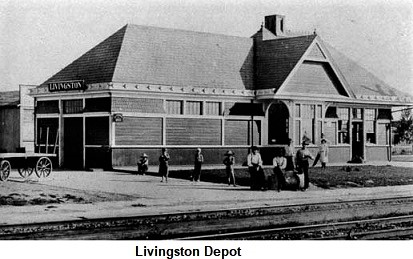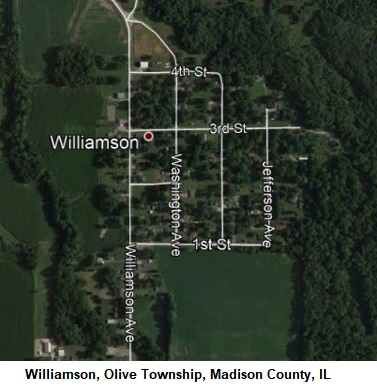Early History of Livingston and Williamson
Recommended Reading: History of Livingston, 1905-2005
John Livingston
John Livingston was born in Ireland, December 25, 1830, and came to
America with his mother in 1846. He supported himself by working as
a day laborer. He married Mary A. J. Brown in 1857, and they became
the parents of eleven children – Sarah Jane, Martha White, Robert
Wilson, Rebecca Elizabeth, Mary Ellen, Margaret Ann, William John,
Jessie Alice, David George, Luella Mae, and Cora Belle.

The Livingston home was the scene of many social gatherings for
state, county, and township officials, as well as family member. On
May 18, 1883, a tornado hit the Livingston family farm, and the home
was demolished. Luella Mae was the only family member home at the
time, and she survived. Mary Livingston died in 1897. John
Livingston died March 11, 1898, at the age of 67. They are both
buried in the New Spangle Cemetery in Livingston.
Founding of Livingston
Mining in Olive Township required railroad construction to transport
the coal. In 1903, the Big Four Cut Off was completed, extending
from Mitchell, northeast through Madison County. A mine shaft was
sunk in section 16, on the property of the John Livingston estate. A
railroad station was established nearby, and christened Livingston.
As soon as the station was established and the mine opened, a
settlement developed. The first five houses were built in 1904. A
town was laid out on section 15 and 16 by the heirs of John
Livingston, on lands bequeathed them by their father. Livingston was
incorporated as a village in 1905. The first president of the
village board was David G. Livingston, son of John Livingston.

Early Schools
A schoolhouse was erected in Livingston in 1907 and enlarged in
1912. By 1912, the schoolhouse contained six rooms. Four of the
Livingston sisters became schoolteachers. Martha was a teacher in
Madison County. Rebecca taught for forty-five years and was
principal of a Granite City School. She was also assistant principal
of the Livingston Grade School. Mary Ellen was a school teacher
prior to her marriage. Margaret served 42 years as an educator. She
was the first principal of the Roxana schools, and was principal of
the Williamson School.
Bank of Livingston
The Bank of Livingston was established September 15, 1911 by D. E.
Aylward & Company. It occupied a two-story brick building.
Early Churches
The Methodist Church in Livingston was erected in the Fall of 1911.
It was near the line of the village of Williamson, and supplied the
spiritual needs of both communities.
Livingston Businesses
In 1912, Livingston had thirteen saloons, and the population was
largely foreign.
THE VILLAGE OF WILLIAMSON
The village of Williamson lies immediately north of Livingston in
sections 9 and 10 of Olive Township. It was laid out by the Mt.
Olive and Staunton Coal Company on land purchased from Henry Liche.
The village was named after the family of John and Mathew
Williamson, whose farm land was included in the village site.
Williamson was incorporated in 1907, with John Commit as village
president; J. Crassen, M. Krupp, George Dyzorus, R. T. McAllister,
Joseph Farrimond, and H. Gray as trustees.
The village was entirely dependent on the coal industry. The great
proportion of dwellings in the village were owned by the coal
company. The majority of miners that lived there were Slavs or
Italians.
A schoolhouse was erected in Williamson, and in 1912 there were 350
children attending.

